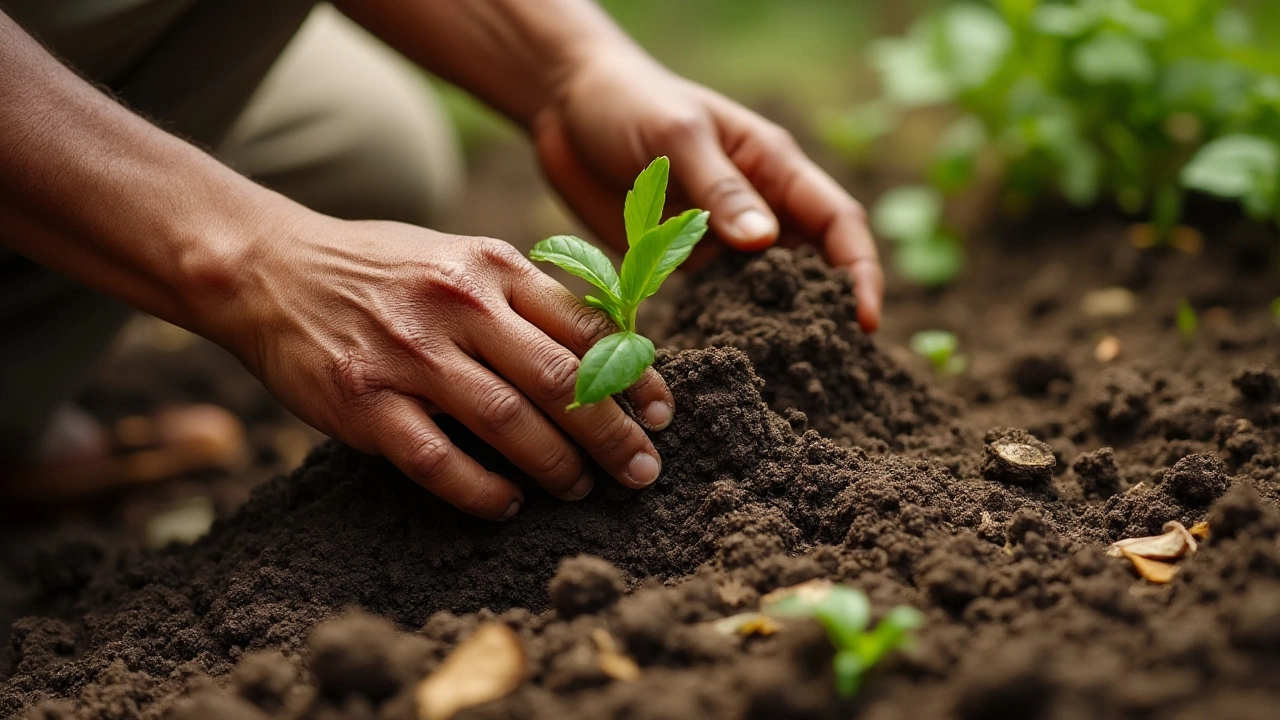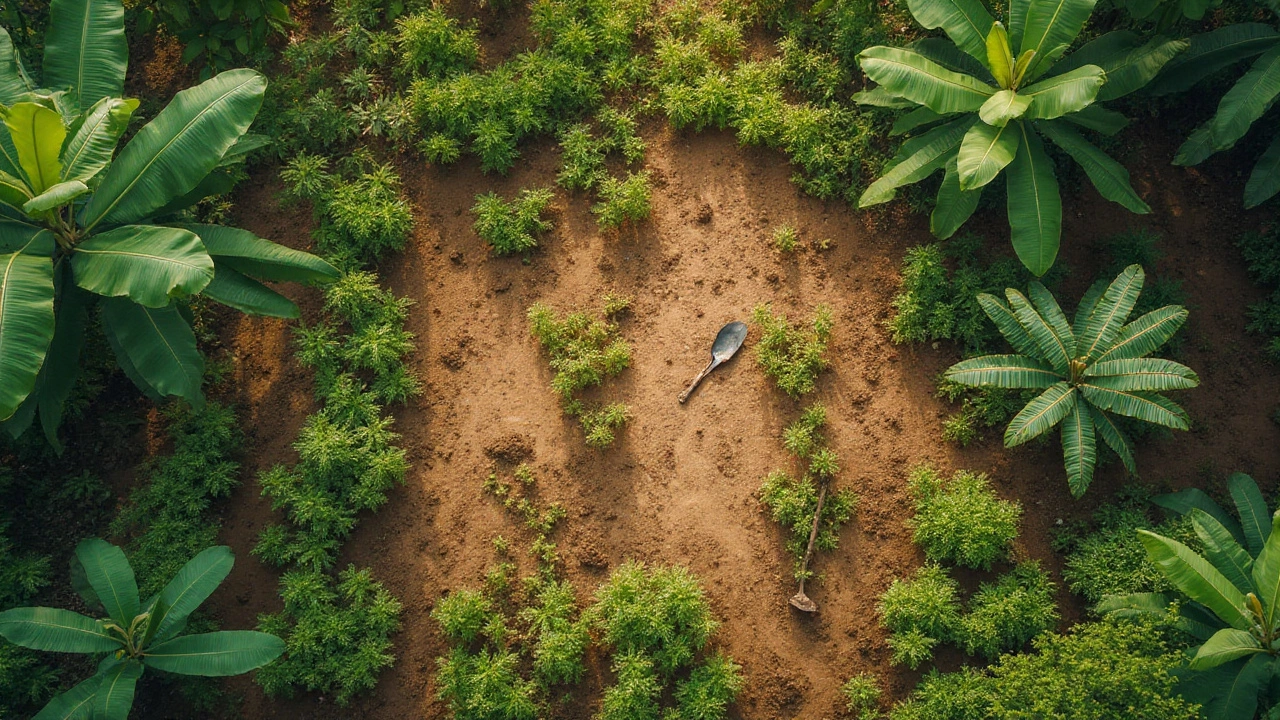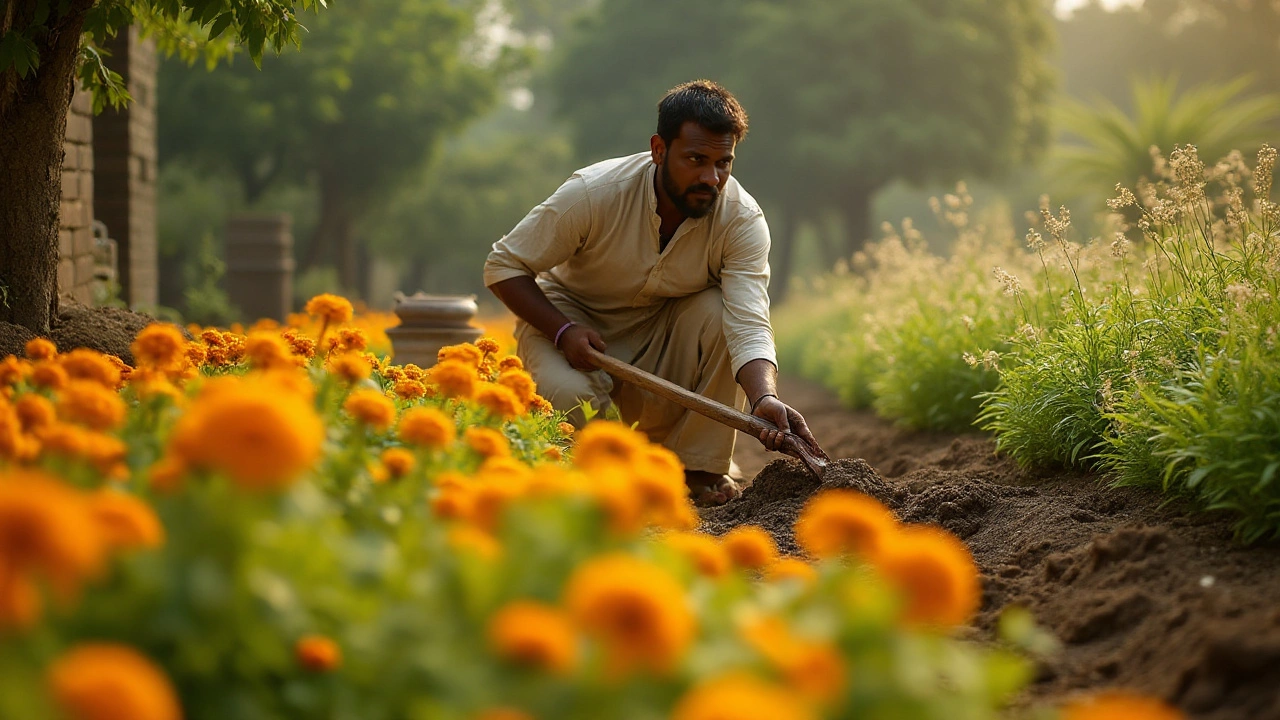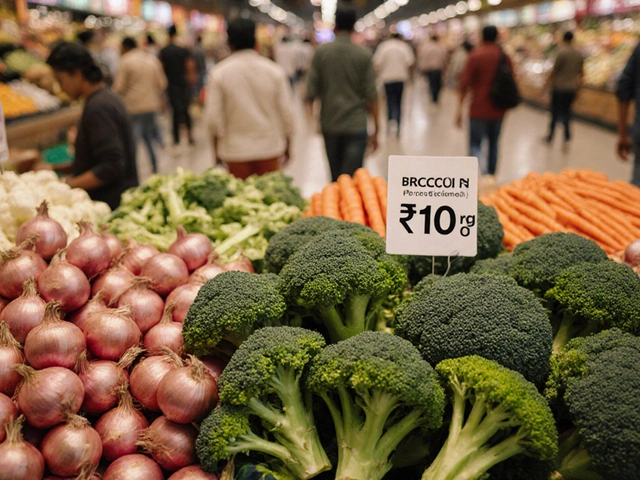Gardening isn't just about planting seeds and watching them grow. It's about understanding the very ground we tend, and ensuring it's as supportive as possible to our growing friends. One common challenge many gardeners face is dealing with loose soil. This kind of soil, while it might seem easy to dig, can actually present a host of problems for plants, such as poor water retention and weak root support.
Without a firm foundation, plants can't always reach their full potential. This article dives into the details of soil firmness, offering solutions both natural and innovative. With step-by-step guidance, you'll learn not just how to tackle the issues at hand, but also how to foster an environment where your garden can truly flourish.
- Understanding the Problem of Loose Soil
- Identifying Soil Composition
- Organic Solutions for Firmer Soil
- Mechanical Techniques to Improve Soil Structure
- Using Mulch and Cover Crops
- Monitoring Soil Health and Improvement Over Time
Understanding the Problem of Loose Soil
When we talk about loose garden soil, we're pointing towards a type of earth that, while seemingly easy to work with, often fails to provide the support and nourishment that plants genuinely need. This lack of structure can result in a range of gardening issues. One primary concern is the inability of the soil to hold water effectively. When soil particles are too far apart, water drains too quickly, leaving plants dehydrated. Not only do they struggle to quench their thirst, but essential nutrients can also be washed away, leading to deficiencies that hinder growth and vitality.
In addition to water retention problems, loose soil typically lacks the compactness necessary for robust root development. Roots act much like anchors, keeping plants steady amidst changing weather conditions. Without a firm hold on the soil, plants become vulnerable to being uprooted during winds or heavy rain. Moreover, nutrient uptake happens more efficiently in soils that offer a balanced resistance. Plants have evolved to interact with their environment, and when the soil is too loose, plants may not respond as they should, often leading to stunted growth.
An interesting fact about soil structure relates to its composition. Ideal garden soil is made up of sand, silt, and clay, in a proportion that often resembles loam. Each component plays a part: sand helps with drainage, clay retains moisture and nutrients, and silt provides a medium ground. If you’re finding excessive looseness in the soil, it could be that the balance is off. An insightful garden enthusiast once said:
"A garden is only as good as its soil; understanding its texture is like having a conversation with the earth."Taking the time to analyze the soil can save a lot of heartache later. It's worth picking up a simple soil test kit to determine its exact composition, offering a clearer path forward towards improvement.
Adding to that, there's another element of nature that helps harden the resolve of loose soils - organic matter. Decomposing plant material, when mixed into soil, breaks down to form humus, a component that binds soil particles together. It acts much like glue, creating pockets that retain moisture and nutrients yet allow roots to travel freely. Helping nature along by mixing compost or well-rotted manure into loose soil can enhance its quality immensely.
For many gardeners, dealing with loose soil isn't just about cultivation; it’s about the frustration of wilting plants and inconsistent yields. Fortunately, with time and perseverance, soil can be transformed. Understanding how these forces within the earth interact is the first step towards creating a thriving garden environment. Being patient, experimenting with different amendments, and observing the results can be hugely beneficial. Remember that nature rewards the patient gardener.
Identifying Soil Composition
Understanding the composition of your garden soil is fundamental in addressing its firmness and overall quality. Soil is a rich tapestry of particles, water, air, and organic matter, each contributing to the overall structure that affects plant growth. The three primary particles found in soil are sand, silt, and clay. They essentially form what is known as the soil's texture. Sand particles are the largest, offering drainage and air flow but can lead to weak soil if not balanced. Silt particles are intermediate in size and feel smooth, improving water retention and nutrient availability. Clay particles are the smallest, often less than 0.002 mm in diameter. While clay can hold nutrients well, its cohesive nature might make soil heavy and compact.
To identify these components, gardeners often resort to a simple texture test, known as the soil jar test. This DIY method requires filling a jar with one-third soil and two-thirds water, shaking it vigorously, and then allowing it to settle over 24 hours. Over time, the layers will separate, with sand settling at the bottom, followed by silt and clay on top. Observing these layers can provide an insightful glimpse into the proportion of each type present, allowing you to align amendments accordingly.
Soil's Organic Matter Influence
While texture is largely unaffected by organic content, the presence of organic material in garden soil is crucial for improving structure and fertility. Organic matter, such as decomposed leaves or compost, can drastically alter the behavior of soil particles, improving water holding capacity and nutrient availability, which aids in the firmness needed for root growth. John Doran, a renowned agronomist, once said,
"Soil is a living ecosystem and is crucial in fostering plant life."This wisdom underscores the importance of nurturing soil life as part of overall garden care.
Testing soil composition professionally can yield detailed results, revealing not only the physical makeup but also pH levels, nutrient availability, and presence of any contaminants. Many agricultural extensions offer detailed testing services that go beyond home diagnosis. With this information, a gardener is well-equipped to make precise changes to ensure their efforts are well-suited to the unique characteristics of their garden soil.
Considering Soil Amendments
Once you've grasped your soil's makeup, consider tailored amendments. Increasing sand will benefit drainage if the soil is too dense. For soils dominated by sand, incorporating organic material or heavier particles like clay can mend their looseness. Several practices, such as layering mulch or incorporating cover crops, play into this adjustment naturally. The goal is to achieve a synergy of particles that supports both plant health and gardening ease, making diagnosing soil composition the first step towards a thriving garden oasis.

Organic Solutions for Firmer Soil
When it comes to enhancing the structure of your garden soil, organic solutions are often the most sustainable and environmentally friendly approach. Garden soil responds exceptionally well to natural amendments that not only firm up the texture but also enrich the nutrient profile. A classic method is the incorporation of compost. Compost works wonders by adding decomposed organic matter, which binds soil particles together, improving its stability. This process not only fortifies the soil but also creates a nutrient-rich environment that boosts plant growth. Home composting allows gardeners to recycle kitchen scraps and garden waste, transforming them into valuable soil conditioners.
Another highly effective organic amendment is aged manure. Adding cow, horse, or chicken manure can significantly alter soil texture. Once properly aged to eliminate pathogens, manure becomes extremely beneficial for the soil structure. It improves water retention while stimulating microbial activity, crucial for soil health. Microbes play a crucial role in breaking down organic matter further and making nutrients more available to plants. This transformation can turn your loose garden soil into a well-aerated, nutrient-dense powerhouse capable of nurturing even the most demanding plants.
Cover crops are also a fantastic option for promoting healthier soil structure. Leguminous plants like clover or vetch, when used as winter cover crops, add immense value. They prevent soil erosion, improve soil porosity, and increase organic matter through root decomposition. As these cover crops grow, their root systems create networks of channels through the soil, enhancing its structure naturally. When tilled back into the soil, they offer an infusion of organic material that anchors soil particles better, an essential step in achieving the desired firmness.
For those interested in more intensive soil care, adding biochar is worth exploring. Produced from plant material burned at high temperatures in a low-oxygen environment, biochar serves as a long-term solution for binding soil particles. Its porous nature allows it to hold nutrients and water, providing the dual benefits of firming and enriching the soil. This ancient technique has been revered for its ability to improve soil structure sustainably.
"The addition of organic materials not only enhances soil fertility but also improves the physical conditions necessary for plant growth," emphasizes the experts at the USDA.
Finally, consider utilizing materials like straw or wood chips as mulch. Mulching is more than just an aesthetic appeal; it's an effective measure to firm up soil. The biodegradable nature of these mulches means that as they break down, they add to the organic content of the soil, helping to compact it naturally without causing compaction. As they decompose, they also bolster microbial communities, maintaining a balance between soil strength and aeration. By experimenting with these organic solutions, gardeners can achieve a robust garden soil that supports healthy plant growth and resilience.
Mechanical Techniques to Improve Soil Structure
When it comes to firming up garden soil, mechanical techniques can play a vital role. These methods often involve physically altering the soil composition and structure, allowing gardeners to create a more stable environment for plant roots. One such approach is tilling, which, when done correctly, can blend different soil layers and introduce air. It also breaks up compacted soil, which can occur naturally over time or through regular foot traffic. However, it is crucial to till when the soil is moist but not wet to avoid damaging the soil structure further. Consistent tilling at the right time of year can significantly increase the soil's firmness.
Compacting is another method to consider, sometimes perceived negatively, but done moderately, it can help achieve the desired soil firmness. This involves using a roller or even just walking over the soil to compress it lightly. This practice should be done with caution, as compressing too much can lead to hardpan—a dense layer that roots and water cannot penetrate. An effective mechanical tool for this task can be a simple garden roller which can be found at most gardening stores.
An interesting fact many gardeners overlook is the use of garden equipment for aeration. Aerating tools, like a core aerator, are specifically designed to perforate the soil, which helps to integrate organic matter into deeper layers. This enhances the soil's capacity to hold nutrients and moisture, promoting healthier plant growth. Regular aeration aligned with organic amendments can improve the soil structure over months significantly.
Tilling Best Practices
When implementing tilling, it is crucial to focus on timing and depth. It is generally best to till in the spring before planting and in the winter when putting the garden to rest. Tilling to a depth of about six to eight inches usually accomplishes adequate soil mixing without exposing too much subsoil. If repeated year after year, deeper-tilling might be necessary to reach the same benefits. However, as an often-overlooked tip, one must ensure they remove visible weeds before tilling to prevent further dispersal throughout the soil.
"Healthy soil has a varied structure that can be harnessed through a combination of biological, chemical, and mechanical methods," says Dr. Emily Stein, an expert in soil science.
Gardening tools, such as broadforks, can also help amplify the effects of deeper tilling without disturbing the surface as much. This technique is especially useful for those tending to root vegetables, which thrive in soil that has a well-structured, firm base.
Implementing Mulch and Weight
Beyond tilling and compacting, using mulch is a mechanical technique that indirectly firms up soil structure by protecting it from erosion and evaporation. Mulch acts as a buffer, and over time, decomposes into organic matter, naturally enriching and firming the soil. Weighing down sheets of mulch with rocks or boards can help guide soil compaction subtly into a more workable state. It’s effective over larger garden beds where immediate planting isn’t planned. This method benefits those who prefer a hands-off approach yet are still aiming for firmer ground.
For those who enjoy a more analytical approach, tracking changes in soil density over time can be illuminating. Here's a basic framework to retain an awareness of ongoing improvements:
| Time Frame | Activity | Outcome |
|---|---|---|
| Spring | Tilling & Aeration | Loosens soil, mixes in organic matter |
| Summer | Compost & Mulch Application | Improves moisture retention and nutrient content |
| Fall | Light Compacting & Cover Crops | Firms soil, adds organic material |
By strategically implementing these mechanical techniques, gardeners are equipped to enhance their soil’s structure effectively, providing a robust foundation for their cherished plants to flourish in a beautifully firm garden soil environment.

Using Mulch and Cover Crops
Gardening is a delicate balance, much like cooking or art. When it comes to firming up that tricky garden soil, using mulch and cover crops isn't just a trick up an experienced gardener's sleeve but a proven method honed over time. Mulch works by covering the soil surface, acting as a natural buffer against the elements. It minimizes erosion and compaction from rain, keeping that loose soil intact. Organic varieties, like bark or straw, slowly decompose, adding precious nutrients back to your soil, creating a self-sustaining cycle.
Wholesale reliance on fertilizers doesn't always yield the best results due to its sometimes harsh nature, so mulches add the benefit of organic matter. Cover crops go hand-in-hand with this process. They're not planted for harvest; they're grown to blanket the soil during the off-season, adding a natural layer of protection and introducing organic matter as they decompose. These living plants also prevent weeds, preserve moisture, and enrich the soil with crucial nitrogen — especially legumes.
"Using cover crops is like giving the land a blanket in winter. It heals, sustains, and prepares it for the next growth cycle," a notion shared by the agricultural scientist Dr. Jane Morrissey.
In choosing the right mulch or cover crop, consider the specific needs of your soil and your climate's unique demands. Each type offers different benefits. For instance, clover not only actively improves soil but also attracts beneficial insects with its blooms. Meanwhile, vetch can be incredibly efficient at fixing nitrogen, enhancing your soil’s productivity over time. A successful garden truly starts with such thoughtful groundwork.
Remember the end game: a thriving garden isn't purely down to aesthetics. It's about sustainability and long-term fertility. The right mulch and cover crops create the ideal conditions for soil improvement, leading to healthier plants and hearty yields. It's a practice steeped in tradition, rooted in simplicity, and with today's environmental considerations more relevant than ever.
Practical Steps for Effective Use
Applying mulch is straightforward, yet there's an art to it: 2-3 inches thick across the garden bed is typically sufficient. Too much, and you risk creating a barrier that water can't penetrate; too little, and it won't do the job. Similarly, once your main crops have been harvested, sow cover crops like rye or barley, allowing them to grow and be tilled back into the soil at the start of the next planting season. The timing and choice of species for your area are paramount to success, and maintaining this vigilance will reward you with endlessly improved soil quality.
Statistics support these practices: gardens using mulch consistently report a 30% reduction in water loss and a notable decline in weed growth. Meanwhile, farmland studies have noted a 20% increase in nutrient-rich soil, particularly when a legume-based cover crop is utilized. Gardening isn't just about choosing plants but enriching the foundation they grow in — the soil is an ecosystem unto itself, and when nurtured properly, the green possibilities ahead are limitless.
Monitoring Soil Health and Improvement Over Time
Creating the perfect garden ecosystem is not a one-time task, but rather a journey that demands continuous attention and care. Monitoring your garden's soil health over time is an essential part of ensuring that your plants receive the nutrients they need. By establishing a routine for checking in on your soil, you'll be able to respond to changes quickly and ensure the soil improvement strategies you've implemented are working effectively.
One effective way to begin is by conducting a simple soil test. These tests can be easily purchased at a local garden center or online. They provide you with valuable insights into the soil’s pH level, nutrient content, and general composition. You should aim to perform these tests at least once a year, though bi-annual checks are encouraged for more accurate monitoring. Regular testing will help you decide if adjustments, like adding lime to raise pH or sulfur to lower it, are necessary to keep your garden soil in balance.
"Healthy soil is the foundation of a productive and sustainable garden," says noted horticulturist Maria Rodale, emphasizing the importance of monitoring soil conditions regularly. Her insights remind us that the health of our soil often dictates the success of everything else we plant.
Another helpful strategy is to keep a garden journal. By noting down changes in plant health, unexpected growth patterns, or any pest infestations, you’ll start seeing patterns and correlations with soil conditions. This historical record can become an invaluable tool in diagnosing problems and planning future soil treatments. Sometimes, visual inspections can reveal issues long before any testing might. Look out for symptoms like stunted plant growth, poor flowering, or an unusual number of weeds; these could indicate a problem with your soil's structure or nutrient levels and might suggest that your firm soil plan needs revisiting.
Using technology can also aid in your monitoring efforts. For tech-savvy gardeners, there are mobile apps that can remind you of when to test your soil and even help interpret the data. Some apps can be linked with weather forecasting to warn you of soil-compacting rain, prompting preventative measures before potential damage occurs. Utilizing these digital tools could add a level of precision and convenience to soil management that was hard to achieve before.
In cases where deeper insights might be necessary, partnering with local agricultural extensions or soil scientists can provide expert assessments. Such partnerships can be particularly beneficial in understanding complex soil issues or when planning major changes, like transitioning to organic alternatives for soil improvement methods. Remember, achieving optimal soil firmness and health isn’t limited to short-term measures; it’s a long-term commitment that evolves with continuous learning and adaptation.
| Soil Component | Importance |
|---|---|
| pH Levels | Affects nutrient availability |
| Soil Texture | Influences water retention and air flow |
| Organic Content | Enhances soil fertility and structure |
Ultimately, the goal is to nurture a garden where plants can thrive naturally in a firm soil that's rich in nutrients and structure. It’s about crafting an environment that feels like a flourishing mini-ecosystem, where your diligent efforts and mother nature work in harmony. As you continue this journey with your garden, let the soil be your guide; its changes and signals are the roadmap to lush and abundant growth.





